Submitting PyErrata Reports
The next major functional area in PyErrata serves to implement user-controlled submission of new comment and errata reports. As before, let's begin by getting a handle on this component's user-interface model before inspecting its code.
14.5.1 User Interface: Submitting Comment Reports
As we've seen, PyErrata supports two user functions: browsing the reports database and adding new reports to it. If you click the "General comment" link in the Submit section of the root page shown in Figure 14-2, you'll be presented with the comment submission page shown in Figure 14-16.
Figure 14-16. Submit comments, input page
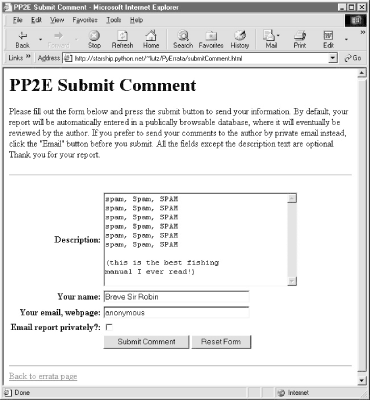
This page initially comes up empty; the data we type into its form fields is submitted to a server-side script when we press the submit button at the bottom. If the system was able to store the data as a new database record, a confirmation like the one in Figure 14-17 is reflected back to the client.
Figure 14-17. Submit comments, confirmation page
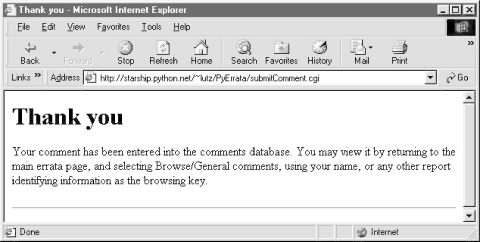
All fields in submit forms are optional except one; if we leave the "Description" field empty and send the form, we get the error page shown in Figure 14-18 (generated during an errata submission). Comments and error reports without descriptions aren't incredibly useful, so we kick such requests out. All other report fields are stored empty if we send them empty (or missing altogether) to the submit scripts.
Figure 14-18. Submit, missing field error page
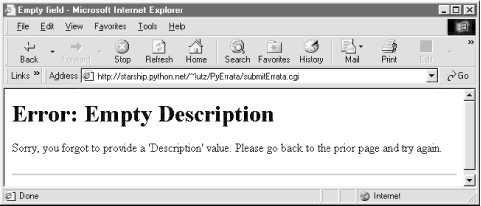
Once we've submitted a comment, we can go back to the browse pages to view it in the database; Figure 14-19 shows the one we just added, accessed by key "Submitter name" and in "With index" display format mode.
Figure 14-19. Submit comments, verifying result
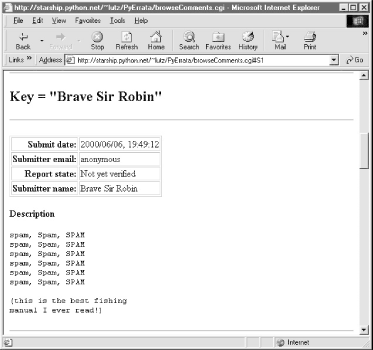
14.5.2 User Interface: Submitting Errata Reports
Here again, the pages generated to submit errata reports are virtually identical to the ones we just saw for submitting comments, as comments and errata are treated the same within the system. Both are instances of generic database records with different sets of fields. But also as before, the top-level errata submission page differs, because there are many more fields that can be filled in; Figure 14-20 shows the top of this input page.
Figure 14-20. Submit errata, input page (top)
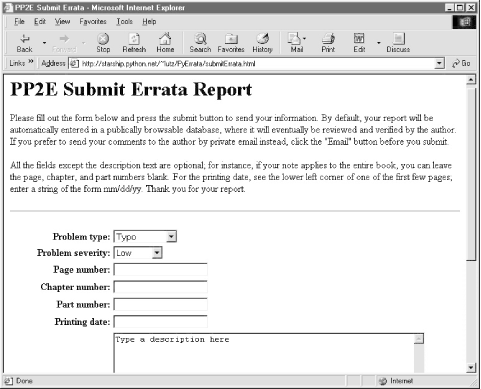
There are lots of fields here, but only the description is required. The idea is that users will fill in as many fields as they like to describe the problem; all text fields default to an empty string if no value is typed into them. Figure 14-21 shows a report in action with most fields filled with relevant information.
Figure 14-21. Submit errata, input page ( filled)
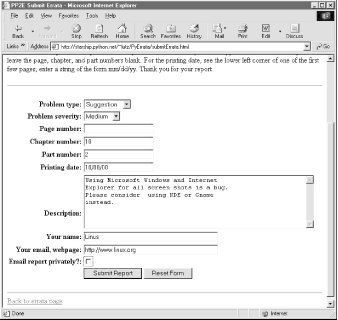
When we press the submit button, we get a confirmation page as before (Figure 14-22), this time with text customized to thank us for an errata instead of a comment.
Figure 14-22. Submit errata, confirmation
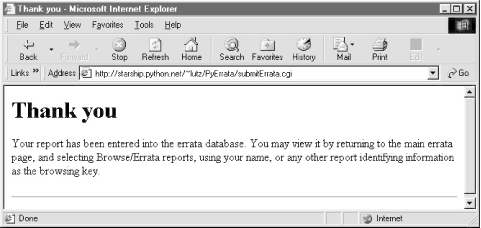
As before, we can verify a submission with the browse pages immediately after it has been confirmed. Let's bring up an index list page for submission dates and click on the new entry at the bottom (Figure 14-23). Our report is fetched from the errata database and displayed in a new page (Figure 14-24). Note that the display doesn't include a "Page number" field: we left it blank on the submit form. PyErrata displays only nonempty record fields when formatting web pages. Because it treats all records generically, the same is true for comment reports; at its core, PyErrata is a very generic system that doesn't care about the meaning of data stored in records.
Figure 14-23. Submit errata, verify result (index)
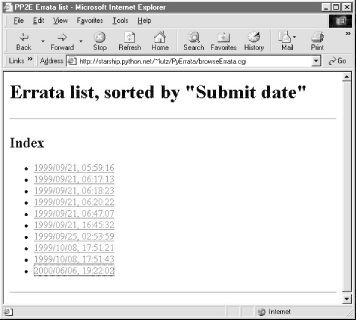
Figure 14-24. Submit errata, verify result (record)
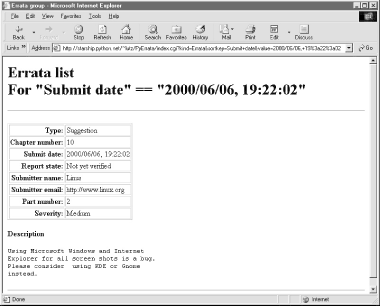
Because not everyone wants to post to a database viewable by everyone in the world with a browser, PyErrata also allows both comments and errata to be sent by email instead of being automatically added to the database. If we click the "Email report privately" checkbox near the bottom of the submit pages before submission, the report's details are emailed to me (their fields show up as a message in my mailbox), and we get the reply in Figure 14-25.
Figure 14-25. Submit errata, email mode confirmation
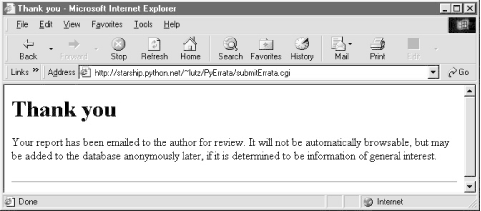
Finally, if the directory or shelve file that represents the database does not grant write access to everyone (remember, CGI scripts run as user "nobody"), our scripts won't be able to store the new record. Python generates an exception, which is displayed in the client's browser because PyErrata is careful to route exception text to sys.stdout. Figure 14-26 shows an exception page I received before making the database directory in question writable with the shell command chmod 777 DbaseFiles/errataDB.
Figure 14-26. Submit errata, exception (need chmod 777 dir)
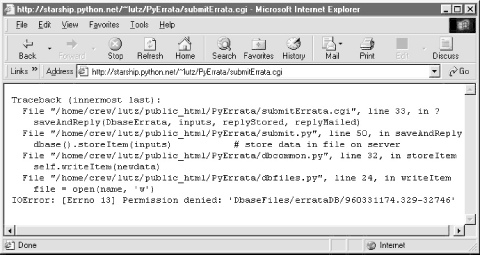
14.5.3 Implementation: Submitting Comment Reports
Now that we've seen the external behavior of PyErrata submit operations, it's time to study their internal workings. Top-level report submission pages are defined by static HTML files. Example 14-8 shows the comment page's file.
Example 14-8. PP2EInternetCgi-WebPyErratasubmitComment.html
PP2E Submit Comment
PP2E Submit Comment
Please fill out the form below and press the submit button to send your information. By default, your report will be automatically entered in a publically browsable database, where it will eventually be reviewed by the author. If you prefer to send your comments to the author by private email instead, click the "Email" button before you submit. All the fields except the description text are optional. Thank you for your report.
| Description: | Type your comment here |
|---|---|
| Your name: | |
| Your email, webpage: | |
| Email report privately?: | |
<a href="pyerrata.html">Back to errata page</a>
The CGI script that is invoked when this file's form is submitted, shown in Example 14-9, does the work of storing the form's input in the database and generating a reply page.
Example 14-9. PP2EInternetCgi-WebPyErratasubmitComment.cgi
#!/usr/bin/python
DEBUG=0
if DEBUG:
import sys
sys.stderr = sys.stdout
print "Content-type: text/html"; print
import traceback
try:
from dbswitch import DbaseComment # dbfiles or dbshelve
from submit import saveAndReply # reuse save logic
replyStored = """
Your comment has been entered into the comments database.
You may view it by returning to the main errata page, and
selecting Browse/General comments, using your name, or any
other report identifying information as the browsing key."""
replyMailed = """
Your comment has been emailed to the author for review.
It will not be automatically browsable, but may be added to
the database anonymously later, if it is determined to be
information of general use."""
inputs = {'Description':'', 'Submit mode':'',
'Submitter name':'', 'Submitter email':''}
saveAndReply(DbaseComment, inputs, replyStored, replyMailed)
except:
print "
" traceback.print_exc( )
Don't look too hard for database or HTML-generation code here; it's all been factored out to the submit module, listed in a moment, so it can be reused for errata submissions too. Here, we simply pass it things that vary between comment and errata submits: database, expected input fields, and reply text.
As before, the database interface object is fetched from the switch module to select the currently supported storage medium. Customized text for confirmation pages (replyStored, replyMailed) winds up in web pages and is allowed to vary per database.
The inputs dictionary in this script provides default values for missing fields and defines the format of comment records in the database. In fact, this dictionary is stored in the database: within the submit module, input fields from the form or an explicit URL are merged in to the inputs dictionary created here, and the result is written to the database as a record.
More specifically, the submit module steps through all keys in inputs and picks up values of those keys from the parsed form input object, if present. The result is that this script guarantees that records in the comments database will have all the fields listed in inputs, but no others. Because all submit requests invoke this script, this is true even if superfluous fields are passed in an explicit URL; only fields in inputs are stored in the database.
Notice that almost all of this script is wrapped in a try statement with an empty except clause. This guarantees that every (uncaught) exception that can possibly happen while our script runs will return to this try and run its exception handler; here, it runs the standard traceback.print_exc call to print exception details to the web browser in unformatted (
) mode.
14.5.4 Implementation: Submitting Errata Reports
The top-level errata submission page in Figures Figure 14-20 and Figure 14-21 is also rendered from a static HTML file on the server, listed in Example 14-10. There are more input fields here, but it's similar to comments.
Example 14-10. PP2EInternetCgi-WebPyErratasubmitErrata.html
PP2E Submit Errata
PP2E Submit Errata Report
Please fill out the form below and press the submit button to send your information. By default, your report will be automatically entered in a publically browsable database, where it will eventually be reviewed and verified by the author. If you prefer to send your comments to the author by private email instead, click the "Email" button before you submit.
All the fields except the description text are optional; for instance, if your note applies to the entire book, you can leave the page, chapter, and part numbers blank. For the printing date, see the lower left corner of one of the first few pages; enter a string of the form mm/dd/yy. Thank you for your report.
| Problem type: | TypoGrammarProgram bugSuggestionOther |
|---|---|
| Problem severity: | LowMediumHighUnknown |
| Page number: | |
| Chapter number: | |
| Part number: | |
| Printing date: | |
| Description: | Type a description here |
| Your name: | |
| Your email, webpage: | |
| Email report privately?: | |
<a href="pyerrata.html">Back to errata page</a>
The script triggered by the form on this page, shown in Example 14-11, also looks remarkably similar to the submitComment script shown in Example 14-9. Because both scripts simply use factored-out logic in the submit module, all we need do here is pass in appropriately tailored confirmation pages text and expected input fields. As before, real CGI inputs are merged into the script's inputs dictionary to yield a database record; the stored record will contain exactly the fields listed here.
Example 14-11. PP2EInternetCgi-WebPyErratasubmitErrata.cgi
#!/usr/bin/python
DEBUG=0
if DEBUG:
import sys
sys.stderr = sys.stdout
print "Content-type: text/html"; print
import traceback
try:
from dbswitch import DbaseErrata # dbfiles or dbshelve
from submit import saveAndReply # reuse save logic
replyStored = """
Your report has been entered into the errata database.
You may view it by returning to the main errata page, and
selecting Browse/Errata reports, using your name, or any
other report identifying information as the browsing key."""
replyMailed = """
Your report has been emailed to the author for review.
It will not be automatically browsable, but may be added to
the database anonymously later, if it is determined to be
information of general interest."""
# 'Report state' and 'Submit date' are added when written
inputs = {'Type':'', 'Severity':'',
'Page number':'', 'Chapter number':'', 'Part number':'',
'Printing Date':'', 'Description':'', 'Submit mode':'',
'Submitter name':'', 'Submitter email':''}
saveAndReply(DbaseErrata, inputs, replyStored, replyMailed)
except:
print "
" traceback.print_exc( )
14.5.5 Common Submit Utility Module
Both comment and errata reports ultimately invoke functions in the module in Example 14-12 to store to the database and generate a reply page. Its primary goal is to merge real CGI inputs into the expected inputs dictionary and post the result to the database or email. We've already described the basic ideas behind this module's code, so we don't have much new to say here.
Notice, though, that email-mode submissions (invoked when the submit page's email checkbox is checked) use an os.popen shell command call to send the report by email; messages arrive in my mailbox with one line per nonempty report field. This works on my Linux web server, but other mail schemes such as the smptlib module (discussed in Chapter 11) are more portable.
Example 14-12. PP2EInternetCgi-WebPyErratasubmit.py
######################################################### # on submit request: store or mail data, send reply page; # report data is stored in dictionaries on the database; # we require a description field (and return a page with # an error message if it's empty), even though the dbase # mechanism could handle empty description fields--it # makes no sense to submit a bug without a description; ######################################################### import cgi, os, sys, string mailto = 'lutz@rmi.net' # or lutz@starship.python.net sys.stderr = sys.stdout # print errors to browser print "Content-type: text/html " thankyouHtml = """
Thank you
Thank you
%s
""" errorHtml = """Empty field
Error: Empty %s
Sorry, you forgot to provide a '%s' value. Please go back to the prior page and try again.
""" def sendMail(inputs): # email data to author text = '' # or 'mailto:' form action for key, val in inputs.items( ): # or smtplib.py or sendmail if val != '': text = text + ('%s = %s ' % (key, val)) mailcmd = 'mail -s "PP2E Errata" %s' % mailto os.popen(mailcmd, 'w').write(text) def saveAndReply(dbase, inputs, replyStored, replyMailed): form = cgi.FieldStorage( ) for key in form.keys( ): if key in inputs.keys( ): inputs[key] = form[key].value # pick out entered fields required = ['Description'] for field in required: if string.strip(inputs[field]) == '': print errorHtml % (field, field) # send error page to browser break else: if inputs['Submit mode'] == 'email': sendMail(inputs) # email data direct to author print thankyouHtml % replyMailed else: dbase( ).storeItem(inputs) # store data in file on server print thankyouHtml % replyStored
This module makes use of one additional database interface to store record dictionaries: dbase( ).storeItem(inputs). However, we need to move on to the next section to fully understand the processing that this call implies.
|
Introducing Python
- And Now for Something Completely Different
- The Life of Python
- The Compulsory Features List
- Whats Python Good For?
- Whats Python Not Good For?
Part I: System Interfaces
System Tools
- The os.path to Knowledge
- Why Python Here?
- System Scripting Overview
- The sys Module
- The os Module
- Script Execution Context
- Current Working Directory
- Command-Line Arguments
- Shell Environment Variables
- Standard Streams
- File Tools
- Directory Tools
Parallel System Tools
- Telling the Monkeys What to Do
- Forking Processes
- Threads
- Program Exits
- Interprocess Communication
- Pipes
- Signals
- Launching Programs on Windows
- Other System Tools
Larger System Examples I
- Splits and Joins and Alien Invasions
- Splitting and Joining Files
- Generating Forward-Link Web Pages
- A Regression Test Script
- Packing and Unpacking Files
- User-Friendly Program Launchers
Larger System Examples II
- The Greps of Wrath
- Fixing DOS Line Ends
- Fixing DOS Filenames
- Searching Directory Trees
- Visitor: Walking Trees Generically
- Copying Directory Trees
- Deleting Directory Trees
- Comparing Directory Trees
Part II: GUI Programming
Graphical User Interfaces
- Heres Looking at You, Kid
- Python GUI Development Options
- Tkinter Overview
- Climbing the GUI Learning Curve
- The End of the Tutorial
- Python/Tkinter for Tcl/Tk Converts
A Tkinter Tour, Part 1
- Widgets and Gadgets and GUIs, Oh My!
- Configuring Widget Appearance
- Toplevel Windows
- Dialogs
- Binding Events
- Message and Entry
- Checkbutton, Radiobutton, and Scale
- Running GUI Code Three Ways
- Images
A Tkinter Tour, Part 2
- On Todays Menu: Spam, Spam, and Spam
- Menus
- Listboxes and Scrollbars
- Text
- Canvas
- Grids
- Time Tools, Threads, and Animation
- The End of the Tour
- The PyDemos and PyGadgets Launchers
Larger GUI Examples
- Building a Better Mouse Trap
- Advanced GUI Coding Techniques
- Complete Program Examples
- PyEdit: A Text Editor Program/Object
- PyView: An Image and Notes Slideshow
- PyDraw: Painting and Moving Graphics
- PyClock: An Analog/Digital Clock Widget
- PyToe: A Tic-Tac-Toe Game Widget
- Where to Go from Here
Part III: Internet Scripting
Network Scripting
- Tune in, Log on, and Drop out
- Plumbing the Internet
- Socket Programming
- Handling Multiple Clients
- A Simple Python File Server
Client-Side Scripting
- Socket to Me!
- Transferring Files over the Net
- Processing Internet Email
- The PyMailGui Email Client
- Other Client-Side Tools
Server-Side Scripting
- Oh What a Tangled Web We Weave
- Whats a Server-Side CGI Script?
- Climbing the CGI Learning Curve
- The Hello World Selector
- Coding for Maintainability
- More on HTML and URL Escapes
- Sending Files to Clients and Servers
Larger Web Site Examples I
- Things to Do When Visiting Chicago
- The PyMailCgi Web Site
- The Root Page
- Sending Mail by SMTP
- Reading POP Email
- Utility Modules
- CGI Script Trade-offs
Larger Web Site Examples II
- Typos Happen
- The PyErrata Web Site
- The Root Page
- Browsing PyErrata Reports
- Submitting PyErrata Reports
- PyErrata Database Interfaces
- Administrative Tools
- Designing for Reuse and Growth
Advanced Internet Topics
- Surfing on the Shoulders of Giants
- Zope: A Web Publishing Framework
- HTMLgen: Web Pages from Objects
- JPython ( Jython): Python for Java
- Grail: A Python-Based Web Browser
- Python Restricted Execution Mode
- XML Processing Tools
- Windows Web Scripting Extensions
- Python Server Pages
- Rolling Your Own Servers in Python
Part IV: Assorted Topics
Databases and Persistence
- Give Me an Order of Persistence, but Hold the Pickles
- Persistence Options in Python
- DBM Files
- Pickled Objects
- Shelve Files
- SQL Database Interfaces
- PyForm: A Persistent Object Viewer
Data Structures
- Roses Are Red, Violets Are Blue; Lists Are Mutable, and So Is Class Foo
- Implementing Stacks
- Implementing Sets
- Binary Search Trees
- Graph Searching
- Reversing Sequences
- Permuting Sequences
- Sorting Sequences
- Data Structures Versus Python Built-ins
- PyTree: A Generic Tree Object Viewer
Text and Language
- See Jack Hack. Hack, Jack, Hack
- Strategies for Parsing Text in Python
- String Module Utilities
- Regular Expression Matching
- Parser Generators
- Hand-Coded Parsers
- PyCalc: A Calculator Program/Object
Part V: Integration
Extending Python
- Extending Python
- I Am Lost at C
- C Extensions Overview
- A Simple C Extension Module
- The SWIG Integration Code Generator
- Wrapping C Environment Calls
- A C Extension Module String Stack
- A C Extension Type String Stack
- Wrapping C++ Classes with SWIG
Embedding Python
- Embedding Python
- Add Python. Mix Well. Repeat.
- C Embedding API Overview
- Basic Embedding Techniques
- Registering Callback Handler Objects
- Using Python Classes in C
- ppembed: A High-Level Embedding API
- Other Integration Topics
VI: The End
Conclusion Python and the Development Cycle
- Conclusion Python and the Development Cycle
- That s the End of the Book, Now Here s the Meaning of Life
- Something s Wrong with the Way We Program Computers
- The Gilligan Factor
- Doing the Right Thing
- Enter Python
- But What About That Bottleneck?
- On Sinking the Titanic
- So What s Python The Sequel
- In the Final Analysis
- Postscript to the Second Edition
- Appendix A Recent Python Changes
- Section A.1. Major Changes in 2.0
- Section A.2. Major Changes in 1.6
- Section A.3. Major Changes Between 1.3 and 1.5.2
- Appendix B Pragmatics
- Section B.1. Installing Python
- Section B.2. Book Examples Distribution
- Section B.3. Environment Configuration
- Section B.4. Running Python Programs
- Section B.5. Python Internet Resources
- Appendix C. Python Versus C++
EAN: 2147483647
Pages: 245

